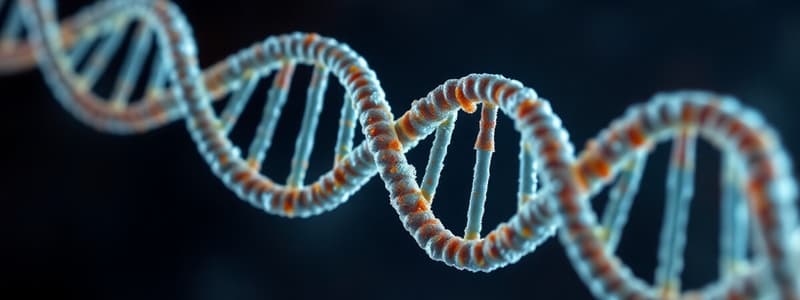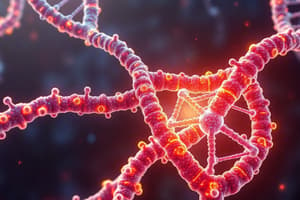Podcast
Questions and Answers
What must be included in the subject line of emails?
What must be included in the subject line of emails?
- Your full name
- The course code ANTHP 105 (correct)
- Lecture date
- Your student ID
When are reading questions due?
When are reading questions due?
- At the end of each unit
- Two weeks after the last exam
- The day before the last exam
- By 11:59 pm on the day of the last exam (correct)
What is the main topic of Lecture 3?
What is the main topic of Lecture 3?
- Chemical Bonds in Living Organisms
- The Evolution of Species
- Introduction to Ecosystems
- Genetic Variation and Chromosomal Inheritance (correct)
Which of the following correctly categorizes cell types?
Which of the following correctly categorizes cell types?
What is one of today's objectives in the lecture?
What is one of today's objectives in the lecture?
What is the primary difference between somatic cells and gametes?
What is the primary difference between somatic cells and gametes?
Which term describes pairs of chromosomes that have the same genes at the same loci?
Which term describes pairs of chromosomes that have the same genes at the same loci?
What is the function of DNA polymerase during DNA replication?
What is the function of DNA polymerase during DNA replication?
What components make up a nucleotide in DNA?
What components make up a nucleotide in DNA?
Which base pairs with adenine (A) in DNA?
Which base pairs with adenine (A) in DNA?
Which of the following best describes the process of denaturation in DNA replication?
Which of the following best describes the process of denaturation in DNA replication?
Which statement correctly identifies a characteristic of gametes?
Which statement correctly identifies a characteristic of gametes?
What is the significance of the triplet code in DNA?
What is the significance of the triplet code in DNA?
What is the primary difference between somatic cells and gametes?
What is the primary difference between somatic cells and gametes?
What role does messenger RNA (mRNA) play in protein synthesis?
What role does messenger RNA (mRNA) play in protein synthesis?
Which statement correctly defines a gene?
Which statement correctly defines a gene?
During transcription in protein synthesis, which substance is created from DNA?
During transcription in protein synthesis, which substance is created from DNA?
What is the primary purpose of proteins in biological organisms?
What is the primary purpose of proteins in biological organisms?
What is a key characteristic of eukaryotic cells compared to prokaryotic cells?
What is a key characteristic of eukaryotic cells compared to prokaryotic cells?
How does the genetic variation occur in populations?
How does the genetic variation occur in populations?
In terms of chromosome number, how do gametes differ from somatic cells?
In terms of chromosome number, how do gametes differ from somatic cells?
What is the primary outcome of meiosis?
What is the primary outcome of meiosis?
Which of the following accurately describes somatic mutations?
Which of the following accurately describes somatic mutations?
What method contributes to genetic variation by creating new combinations of alleles?
What method contributes to genetic variation by creating new combinations of alleles?
What process occurs during meiosis that increases genetic diversity by exchanging genetic material?
What process occurs during meiosis that increases genetic diversity by exchanging genetic material?
Which cellular structure is associated with protein synthesis?
Which cellular structure is associated with protein synthesis?
In the context of gametes, what term describes cells that are haploid?
In the context of gametes, what term describes cells that are haploid?
Which type of mutation is a source of new genetic variation?
Which type of mutation is a source of new genetic variation?
What is the primary function of mitosis?
What is the primary function of mitosis?
Flashcards are hidden until you start studying
Study Notes
The Cell
- Prokaryotes are single-celled organisms with no membrane-bound nucleus
- Eukaryotes are organisms with a membrane-bound nucleus and more complex internal structures
- Somatic cells are all body cells that are diploid
- Gametes are reproductive cells that are haploid
DNA Structure
- DNA consists of two chains of nucleotides, each of which is composed of nitrogenous bases, sugar (deoxyribose), and a phosphate group.
- Nitrogenous bases are adenine (A), cytosine (C), guanine (G), and thymine (T).
- Adenine (A) pairs with thymine (T) and cytosine (C) pairs with guanine (G).
DNA Replication
- Replication is the process of copying DNA. It occurs in three stages:
- Denaturation: the DNA double helix is unwound by helicase.
- Annealing: primase lays down a short RNA primer for DNA polymerase to use.
- Extension: DNA polymerase adds nucleotides to the primer.
Gene Expression and Protein Synthesis
- A gene is a sequence of DNA that codes for a protein.
- Protein synthesis occurs in two steps:
- Transcription: DNA is used as a template to create messenger RNA (mRNA).
- Translation: mRNA is used as a template to create a sequence of amino acids.
Cellular Division
- Mitosis is a type of cell division that produces two identical daughter cells.
- Meiosis is a type of cell division that produces four unique daughter cells.
- Meiosis produces gametes.
Mutations
- Mutations are changes in the DNA sequence.
- Mutations can be beneficial, harmful, or neutral.
- Mutations are a source of new genetic variation.
Genetic Variation
- Genetic variation is the differences in the genetic makeup of individuals. This is caused by:
- Mutations: Changes in the DNA sequence.
- Random assortment: A random combination of maternal and paternal chromosomes inherited by a child.
- Recombination (crossing over): The exchange of genetic material between homologous chromosomes during meiosis.
Key Terms
- Homologous pairs
- Mitosis
- Meiosis
- Somatic cell
- Gamete
- RNA
- mRNA
- Transcription
- Translation
- tRNA
- Uracil
- Thymine
- Ribosome
- Sexual reproduction
- Asexual reproduction
- Mutation
- Somatic vs. germ-line mutation
- Random assortment
- Recombination (crossing over)
Studying That Suits You
Use AI to generate personalized quizzes and flashcards to suit your learning preferences.




